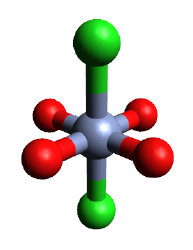Chromium(II) chloride

| |

| |
| Names | |
|---|---|
| IUPAC name
Chromium(II) chloride
| |
| Other names
Chromous chloride
| |
| Identifiers | |
| |
3D model (
JSmol ) |
|
| ChemSpider | |
ECHA InfoCard
|
100.030.136 |
| EC Number |
|
PubChem CID
|
|
RTECS number
|
|
| UNII |
|
| UN number | 3077 |
CompTox Dashboard (EPA)
|
|
| |
| |
| Properties | |
| Cl2Cr | |
| Molar mass | 122.90 g·mol−1 |
| Appearance | White to grey/green powder (anhydrous) blue solid (tetrahydrate) |
| Odor | Odorless |
| Density | 2.88 g/cm3 (24 °C)[1] |
| Melting point | 824 °C (1,515 °F; 1,097 K) anhydrous 51 °C (124 °F; 324 K) tetrahydrate, decomposes[1] |
| Boiling point | 1,302 °C (2,376 °F; 1,575 K) anhydrous[1] |
| Soluble[1] | |
| Solubility | Insoluble in alcohol, ether |
| Acidity (pKa) | 2 |
| +7230·10−6 cm3/mol | |
| Structure | |
| Pnnm, No. 58 (anhydrous)[2] P21/c, No. 14 (tetrahydrate)[3] | |
| 2/m 2/m 2/m (anhydrous)[2] 2/m (tetrahydrate)[3] | |
a = 6.64 Å, b = 5.98 Å, c = 3.48 Å (anhydrous)[2] α = 90°, β = 90°, γ = 90°
| |
Octahedral (Cr2+, anhydrous)[2]
| |
| Thermochemistry | |
Heat capacity (C)
|
71.2 J/mol·K[1] |
Std molar
entropy (S⦵298) |
115.3 J/mol·K[1] |
Std enthalpy of (ΔfH⦵298)formation |
−395.4 kJ/mol[1] |
Gibbs free energy (ΔfG⦵)
|
−356 kJ/mol[1] |
| Hazards | |
| GHS labelling: | |
 [4] [4]
| |
| Warning | |
| H302, H315, H319, H335[4] | |
| P261, P305+P351+P338[4] | |
| NFPA 704 (fire diamond) | |
| Lethal dose or concentration (LD, LC): | |
LD50 (median dose)
|
1870 mg/kg (rats, oral)[5] |
| Safety data sheet (SDS) | Oxford MSDS |
| Related compounds | |
Other anions
|
Chromium(II) fluoride Chromium(II) bromide Chromium(II) iodide |
Other cations
|
Chromium(III) chloride Chromium(IV) chloride Molybdenum(II) chloride Tungsten(II) chloride |
Except where otherwise noted, data are given for materials in their standard state (at 25 °C [77 °F], 100 kPa).
| |
Chromium(II) chloride describes
Synthesis
CrCl2 is produced by reducing chromium(III) chloride either with hydrogen at 500 °C:
- 2 CrCl3 + H2 → 2 CrCl2 + 2 HCl
or by electrolysis.
On the laboratory scale, LiAlH4, zinc, and related reductants produce chromous chloride from chromium(III) precursors:
- 4 CrCl3 + LiAlH4 → 4 CrCl2 + LiCl + AlCl3 + 2 H2
- 2 CrCl3 + Zn → 2 CrCl2 + ZnCl2
CrCl2 can also be prepared by treating a solution of chromium(II) acetate with hydrogen chloride:[6]
- Cr2(OAc)4 + 4 HCl → 2 CrCl2 + 4 AcOH
Treatment of chromium powder with concentrated
- Cr + n H2O + 2 HCl → CrCl2(H2O)n + H2
Structure and properties
Anhydrous CrCl2 is white

The hydrated derivative, CrCl2(H2O)4, forms
Reactions
The reduction potential for Cr3+ + e− ⇄ Cr2+ is −0.41. Since the reduction potential of H+ to H2 in acidic conditions is +0.00, the chromous ion has sufficient potential to reduce acids to hydrogen, although this reaction does not occur without a catalyst.
Organic chemistry
Chromium(II) chloride is used as precursor to other inorganic and organometallic chromium complexes. Alkyl halides and nitroaromatics are reduced by CrCl2. The moderate electronegativity of chromium and the range of substrates that CrCl2 can accommodate make
References
- ^ ISBN 978-1-4200-9084-0.
- ^ .
- ^ .
- ^ a b c Sigma-Aldrich Co., Chromium(II) chloride. Retrieved on 2014-07-04.
- ^ a b "MSDS of Chromium(II) chloride". fishersci.ca. Fisher Scientific. Retrieved 2014-07-04.
- ^ ISBN 978-0121266011.)
{{cite book}}:|first=has generic name (help)CS1 maint: multiple names: authors list (link - ISBN 9780470132418.
- ISBN 978-0-08-037941-8.
- .
- .

